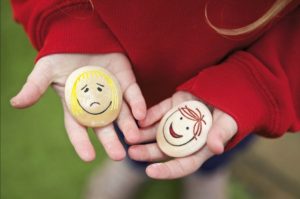 Everyone has emotions, but how do we express them? If you’re looking for a healthy way to help young students communicate their emotions, try using Emotion Stones! Emotion Stones can help children process their own emotions through the recognition of facial expressions, and can also be used to help them recognize the emotions of others. There are 12 Emotion Stones in a set: Happy (pleased), sad (upset), angry, surprised, frightened, worried, proud, confused, calm, bored, shy, and embarrassed.
Everyone has emotions, but how do we express them? If you’re looking for a healthy way to help young students communicate their emotions, try using Emotion Stones! Emotion Stones can help children process their own emotions through the recognition of facial expressions, and can also be used to help them recognize the emotions of others. There are 12 Emotion Stones in a set: Happy (pleased), sad (upset), angry, surprised, frightened, worried, proud, confused, calm, bored, shy, and embarrassed.
There are many ways to use Emotion Stones in your classroom! To teach emotions through games, you can lay the stones face down and ask students to turn them over one at a time, having them identify each emotion and make their own face to match. Or, you can choose a stone and have students act out emotions for their classmates to guess. To help students to engage with emotions in a thoughtful manner, you can pass the stones around your classroom and ask students to reflect on when they’ve felt each emotion. If students are experiencing conflict or crisis, you can ask them to select the stone that matches their or their classmate’s emotions and reflect on why they are feeling that way. Students may also find that the flat, smooth stones are soothing to hold.
Emotion Stones can also be a great reinforcement tool for introducing students to other types of self-expression. For teachers looking to incorporate nonverbal communication in their classrooms, Emotion Stones can be paired with ASL (sign language) cards. For older students, Emotion Stones can also be paired with conversation cubes.
To try out the Emotion Stones, or to consult the instructions for even more activities, stop by the Play and Display area on the 3rd floor of the Library. For more activities on oral communication, you can search the OISE Library K-12 Manipulative Database or visit the 3rd floor of the Library.
